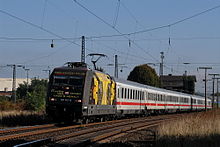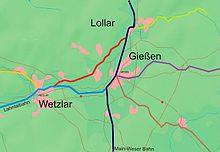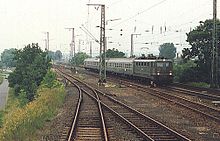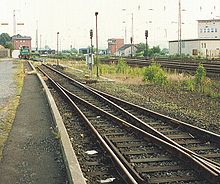Lollar train station
| Lollar | |
|---|---|
|
A passing freight train on platform 11, the "Lf" signal box in the background
|
|
| Data | |
| Location in the network | Separation station |
| Design | Island station |
| Platform tracks | 3 (previously 7) |
| abbreviation | FLOL |
| IBNR | 8000234 |
| Price range | 5 |
| opening | August 25, 1850 |
| Profile on Bahnhof.de | Lollar |
| Architectural data | |
| Architectural style | Neo-Gothic |
| location | |
| City / municipality | Lollar |
| country | Hesse |
| Country | Germany |
| Coordinates | 50 ° 38 '52 " N , 8 ° 42' 4" E |
| Height ( SO ) | 168 m above sea level NHN |
| Railway lines | |
|
|
| Railway stations in Hessen | |
The Lollar station is an island station in Central Hesse on route kilometer 125.9 of the Main-Weser Railway . The former railway junction is a cultural monument according to the Hessian Monument Protection Act .
history
Lollar station was opened on July 25, 1850 at the same time as the Main-Weser Railway . At that time it was located about 500 meters north of today's train station. The local road at the old station still indicates this today.
With the start of rail traffic, freight traffic, which, due to the levying of bridge tolls, flushed a lot of money into the city coffers, shifted to rail within a short time, so that important income was lost. Therefore, many residents were skeptical about the railway and feared that the place would become impoverished.
With the construction of the Lollar – Wetzlar railway , which was part of the Kanonenbahn ( Berlin - Metz ) and was to be expanded to two tracks (individual bridges were already designed for double-track operation), the station area was completely rebuilt. The through station was moved 500 meters to the south and equipped with a much larger reception building. This was in the middle of the track system, so Lollar became an island station . In 1879, one year after the branch line opened, the new station was opened. Thanks to the new route, a further regional center could be reached after Frankfurt am Main with Siegen .
With the commissioning of the Lumdatalbahn to Grünberg on June 1, 1902, Lollar became a regional railway junction with heavy traffic. However, this branch line was used exclusively for regional and freight traffic. In addition, most of the trains were tied to neighboring Gießen from the start.
After the Londorf – Grünberg section of the Lumdatalbahn was shut down on May 26, 1963, and a connection with the Vogelsbergbahn without having to change trains, the decline of the railway age began at the Lollar junction too. Passenger traffic to Wetzlar ended on May 30, 1980, and a year later the remainder of the Lumdatalbahn to Londorf station was over . However, both routes were in densely populated areas and would have allowed further operation. The last passenger train to Londorf was accompanied by many demonstrators calling for traffic to continue.
On February 28, 1983, freight traffic on the Lollar – Abendstern section (route to Wetzlar) was stopped, which was shut down in 1991. In the same year, goods traffic on the Lumdatalbahn also ended in the Didier-Werke –Londorf section.
At the end of the 1980s there was extensive renovation work in the northern area of the station. The track field was changed so that the Lumdatalbahn trains can now approach the western section of the station. Therefore, the tracks of this railway line (3–5) were shortened, which since then can no longer be approached from the north. At that time, in addition to the continuous operation of the Main-Weser-Bahn, there was only freight traffic on the Lumdatalbahn and individual loads at the goods shed. With this measure, the capacity of the station was restricted.
With the beginning of the 1990s, efforts germinated to reactivate the Lumdatalbahn to Londorf station in local passenger traffic. In 1993 and 1996 special trips to Allendorf (Lumda) with railcars of the Hessische Landesbahn were carried out on weekends in the summer months . On August 25, 1995 the Lumdatalbahn AG was founded, which takes on the reactivation of the line to Londorf. In 1997 there were test drives with brand-new trains of the “Talent” type, but these were only possible as far as Mainzlar. Since then there have only been a few special trips.
At the end of the 1990s, the loading of single wagons was stopped. Access was via the Lumdatalbahn track. The loading track at the goods shed was used for loading until around 2000, the last time scrap was being loaded from the loading ramp. In addition, combine harvesters were occasionally unloaded from a K-wagon at the head ramp. Since then, nothing has been loaded or unloaded in Lollar.
Railway systems
Reception building
The first reception building for Lollar from 1849/50 was located in the first train station in the village, which was about 500 m north of the present day. It comes from Julius Eugen Ruhl , has been privatized and preserved. The local road at the old station leads there.
The current station building , the "new" station, was opened in 1879. It is a brick building and stands between the tracks, which makes Lollar an island train station. The building is divided into a two-story south building, a single-story center section and a three-story north building. It includes, among other things, a waiting hall, a ticket office, an overnight room for train drivers and a train station restaurant, all of which have now been closed. The ticket issuing facility was open until 1989, and express goods processing was attached to it. The station restaurant was closed in the late 1980s. Then it opened twice more in shorter periods of time by other tenants. The building is to serve as a location for a cultural cooperative.
Access to the station is from the north via the underpass on Bahnhofsstraße.
Track systems
The Lollar station used to have extensive track systems with over 20 tracks. Today only four are driven on, the rest are dismantled or impassable. The platforms on tracks 1 and 2 are connected by an underpass. Here is a list of the main tracks in the station:
- Track 1 is a through track and is located on the eastern house platform of the Lollar train station. Here the passenger trains run south, i.e. to Frankfurt am Main via Gießen, Butzbach, Bad Nauheim and Friedberg.
- Track 2 is also a through track. Here the trains run in a northerly direction, i.e. to Kassel via Niederwalgern, Marburg, Cölbe, Kirchhain, Stadtallendorf, Treysa and Wabern. It can only be reached via the underpass, which has a staircase at the northern end of the platform.
- Track 3 shared a central platform with track 2. This is where the Lumdatalbahn trainsdeparted and went to Grünberg until 1963 and to Londorf until 1981. At the end of the 1980s it was shortened to a stump track, which - like tracks 4 and 5 since then - could only be approached from the south. In the summer of 1999 it was shut down and dismantled.
- Track 4 was also used by the Lumdatalbahn trains. It had an intermediate platform , which was between it and platform 3. In contrast to the platforms on tracks 1/8, 2/3 and 11, the platform was not fastened, but only piled up.
- Track 5 was east of track 4 and served as a storage and goods track. It had no platform and, like tracks 3 and 4, was dismantled in the summer of 1999.
- Track 7 was a loading track at the goods shed and the adjoining loading ramp. When the loading of goods was stopped around 2000, it lost its function and was shut down. Today it is dismantled.
- Track 8 was a butt track of the cannon railway . It ended south in front of the station building and was west of the platform, which is also on track 1. This is where the passenger trains from Wetzlar usually ended. It was dismantled at the end of the 1970s after trains had been using track 11 since 1977.
- Track 9 was used to move locomotives. It was west of platform 8 and also ended south of the reception building. It was dismantled some time before track 8.
- Track 10 was a pull-out track in the northern part of the station. It is right in front of the fence leading to the Buderus factory premises. In the meantime, however, it has been separated from the rail network.
- Track 11 is on the west side of the reception building. This is where the Kanonenbahn passenger trains to Wetzlar, starting in Lollar, left between 1977 and 1980. It is available for overhaul today. After extensive renovation work in the northern track field towards the end of the 1980s, it can also be used by the Lumdatalbahn trains. Therefore, the special trains to Mainzlar leave on this track so as not to disrupt the operation of the Main-Weser Railway.
- Track 12 was on an unpaved intermediate platform. It mainly served the trains to Wetzlar. In the 1980s, it was dismantled to the stump track and could only be approached from the south. It has now been shut down and is no longer connected to the rail network.
- Track 13 is - like track 12 - on the western side of the reception building. Track 13 has no platform, but the route to Mainzlar can be laid from the signal box. This is where the Lumdatalbahn freight trains go to Mainzlar. A switch leads from track 13 to the intact but unused siding of the ironworks.
- Track 14 was between tracks 13 and 15. Due to the very small distance to the neighboring tracks (standard clearance profile), it was dismantled a long time ago.
- Track 15 , like tracks 13, 14 and 16, was a continuous freight track. Today it is closed and due to the removal of points it is no longer passable.
- Track 16 has also been shut down and has become impassable due to the removal of points. A few shunting and loading tracks branched off here. It was the westernmost through track of the station.
- Track 17 was a short stump track and led into the small locomotive shed. A Köf type small locomotive was stationed there and was doing shunting work in the station.
- Track 19 was on a waste mountain and branched off from track 20. It was used to shunt freight trains.
- Track 20 was in the southern former track field pointing towards Wetzlar. It had a loading station for washing gravel from the neighboring gravel mining area, which was used until mining stopped in the early 1970s. The local recreation area Wißmarer See has been in the former pit since 1973.
Swell:
Further railway buildings

Behind the southern side of the reception building there is a garage-like building on the former buffer stop of track 8 (between tracks 1 and 11), which has been unused for several years. In the past, an electrically operated "cart" with a battery was housed there, which loaded and unloaded express goods from the trains. This was taken with her to the express goods processing facility that is spatially attached to the ticket issuing facility. This was discontinued at the end of the 1980s.
There was also a social building between tracks 11 and 8, which was located next to the garage. However, when track 8 was dismantled, this building was demolished.
There was also a signaling facility. The building was demolished in June 2009 after a long vacancy.
Signal boxes
Because of the branching off routes and the extensive track systems, there were once two signal boxes in Lollar. The signal box Lf was located north of the reception building between tracks 1 and 11. It was built around 1880 and served until November 9, 1969. The demolition began just one day later. The second signal box, Ls , was located next to the Lumdabrücke in the southern end of the station and has also been demolished. In 1967, with the electrification of the Main-Weser-Bahn in the northern area of the station, a new dispatcher interlocking was put into operation.
The Sp Dr S60 interlocking opened in 1967 is called Lf and is manned by a dispatcher throughout. It is located between the tracks and Justus-Kilian-Straße . A commemorative publication was published in 2007 to mark the 40th anniversary of the new signal box.
Locomotive and goods shed
A small locomotive shed stood south of the signal box and was connected to the rest of the track network with track 17. It was a single shed made of corrugated iron with a window at the top on two sides. It housed a small Köf locomotive that did shunting work in the station. There were a couple of signs inside. In the 1970s there was an accident that severely damaged the locomotive shed: a shunting department unintentionally drove through the shed and broke through the rear wall. In May 2008 it was demolished after it was vacant along with other buildings at the signal box.
The local freight facility is located in the northern track field next to the old station building. It consisted of a loading ramp with loading lane, a goods shed and a storage and parking area. Although the loading ramp was still used until around 2000, the neighboring goods shed has been empty since the handling of goods was abandoned in the mid-1970s. It is to be demolished in the near future as it is badly damaged. The access is via the street Am alten Bahnhof , which also leads to the old reception building.
Service offer
All regional trains running on the Main-Weser-Bahn and the Mittelhessen-Express ( Treysa - Frankfurt Hbf ) stop in Lollar . The Regional-Express Kassel Hbf - Frankfurt Hbf and the InterCitys pass through the station without stopping, but stop in Giessen, eight kilometers away . The trains are operated by Deutsche Bahn AG and the Hessische Landesbahn (HLB) .
The Mittelhessen-Express has been running since 2006 (initially SE 30, since 2017 RB 41). It starts in Treysa and stops at every stop until Gießen. There it is coupled with the train coming from Dillenburg and drives to Frankfurt, where it only stops in larger cities. With the 2010/2011 timetable change on December 12, 2010, the Hessian state railway took over the transport services of the RB 30 (now RB 98) Marburg-Gießen, which no longer stops in Lollar. During rush hour there are additional repeater trains, some of which deviate from the conventional routes. Lollar station is in the tariff area of the Rhein-Main-Verkehrsverbund (RMV). There is a ticket machine in front of the building. The RMV tariff for Lollar is 1556. Passenger traffic is currently (as of 2019) between 4:20 a.m. and 2:11 a.m., Saturday and Sunday continuously, goods traffic takes place daily for 24 hours.
Train lines
| line | Train run | Tact | operator |
|---|---|---|---|
| RE 30 |
Main-Weser-Bahn Marburg (Lahn) - Niederwalgern - Lollar - Gießen - Butzbach - Bad Nauheim - Friedberg (Hess) - Frankfurt (Main) Hbf |
individual trains | DB regional center |
| RB 41 |
Central Hesse Express Treysa - Kirchhain (Bz Kassel) - Cölbe - Marburg (Lahn) - Niederwalgern - Lollar - Gießen - Butzbach - Bad Nauheim - Friedberg (Hess) - Frankfurt (Main) Hbf |
60 minutes, usually 30 minutes on weekdays | DB regional center |
(As of 2019)
The journey time to Giessen takes nine minutes, to Frankfurt am Main it is 57 minutes with the Mittelhessen-Express and 52 minutes with the Main-Sieg-Express. In the other direction, Marburg can be reached in 20 to 26 minutes. When traveling to Kassel, you have to change trains in Marburg or Treysa.
|
←
|
Lines |
→
|
||
|---|---|---|---|---|
| Fronhausen (Lahn) |
Frankfurt Hbf – Marburg |
to water | ||
| Friedelhausen |
Main-Sieg-Express |
Giessen Oswaldsgarten | ||
| Friedelhausen |
Mittelhessen-Express |
Giessen Oswaldsgarten | ||
Special traffic
Every year the Schmaadleckermarkt takes place in Lollar on the first Sunday in September . Special trains, which start and end in Lollar, run to this grocer's market on the remnants of the Lumdatalbahn. In 2007, 600 people took advantage of the offer. There are also special transports for other events such as the car-free Sunday in Lumdatal, some of which are carried out with historic rail vehicles. The special trains usually depart from platform 11 (west of the reception building). It was planned to let special trains run on the Lumdatalbahn during the Hessentag 2012 in Wetzlar .
Location / integration into the city
The train station is located in the western part of the city and separates the housing estate from an industrial area. To the east of Lollar runs the federal highway 3 , which has been extended to four lanes to become the " yellow autobahn " , with which Marburg and Gießen can be reached quickly. It also runs to Frankfurt am Main and Kassel . The closest junction is called Staufenberg-Süd / Lollar-Süd and can be reached by car in around two minutes.
In the northern area of the station, Bahnhofstrasse crosses under the railway line. A path branches off from it between the eastern and western tracks, which leads to a parking lot to the north of the reception building, which is also between the tracks.
In the area of the former goods shed, additional parking spaces with partial P&R character are to be created.
bus connections
Lollar is connected to the regional bus network with three lines. Except for line 52, all of them stop near the train station. A stop station does not exist. The closest bus stop, Lollar Ortsmitte, on Marburger Strasse is 500 meters away. The following lines stop there:
- Line 51: (Gießen -) Lollar - Ruttershausen - Odenhausen - Salzböden
- Line 520: Gießen - Lollar - Staufenberg - Allendorf - Rabenau - Grünberg
Web links
- Location, tracks, signals and permissible speeds of the station on the OpenRailwayMap
Individual evidence
- ↑ abbreviation
- ↑ Station categories 2012 (PDF; 408 kB)
- ↑ a b c Lollar area: History section ( Memento from September 27, 2013 in the Internet Archive )
- ↑ Query of the course book route 620 at Deutsche Bahn.
- ^ State Office for the Preservation of Monuments Hesse (ed.): Railway in Hesse. Cultural monuments in Hessen .
- ↑ Data on the Lumdatalbahn ( Memento from February 9, 2007 in the Internet Archive )
- ↑ a b c d e f g h Historical pictures of the Gießen – Lollar – Londorf route ( Memento from March 4, 2016 in the Internet Archive )
- ↑ Citizens' engagement ( Memento from September 27, 2013 in the Internet Archive )
- ↑ Picture gallery with almost 200 pictures of the Lumdatalbahn and the Lollar train station ( Memento from September 27, 2013 in the Internet Archive )
- ^ Siegfried Lohr : Planning and buildings by the Kassel master builder Julius Eugen Ruhl 1796–1871. A contribution to the building history of Kassel and Kurhessen in the 19th century . Masch. Diss. Darmstadt [1982], p. 356.
- ↑ Jonas Wissner: These are the creative plans for the Lollar train station . Gießener Allgemeine, February 12, 2019, accessed on June 5, 2019.
- ↑ An artificial elevation by backfilling a track that makes maneuvering easier.
- ↑ a b Photos of the Main-Weser Railway and the Lollar train station
- ↑ signal box list
- ↑ Timetable DB 30
- ↑ Hessenschiene No. 69
- ↑ Special trips on the Lumdatalbahn ( Memento from September 14, 2013 in the Internet Archive )
- ↑ Special traffic to the Schmaadleckermarkt ( Memento from September 27, 2013 in the Internet Archive )
- ↑ [1] (PDF file)
- ↑ Archived copy ( memento of the original from October 15, 2018 in the Internet Archive ) Info: The archive link was inserted automatically and has not yet been checked. Please check the original and archive link according to the instructions and then remove this notice. (PDF file)
- ↑ [2] (formerly line 520) (PDF file)






